As I wrote in the original review of the Columbia River Knife and Tool Hissatsu on these pages, the design of this knife is not new. It is a collaboration between its designer, John Williams of the Bugei Trading Company, and CRKT, the Oregon-based knife company known for its inexpensive, imported tactical folders and sporting tools. Williams’ love of Asian blades is obvious in the Hissatsu, which is distinctly Japanese in appearance. From the tanto-style blade to the pebbled Kraton handle (which mimics the traditional rayskin of a katana grip), the Hissatsu evokes images of stone-faced samurai warriors and even menacing Yakuza enforcers.
The Hissatsu was the subject of lengthy discussions in online cutlery boards in years past. When Bugei first marketed it, the asking price was a few hundred USD — making the knife unobtainable to many. To complicate matters, fit and finish of the knife and its reportedly loose-fitting scabbard were allegedly very rough. The consensus seemed to be that the Hissatsu simply was not worth the money.
At the same time, the Hissatsu’s marketing was… well, personally offensive. I remember seeing a print ad for it containing copy that went something like, “You’ve never fought for your life, you’ve never been on the front lines, and you’ve never had to be there and do that. We can tell because of the knives you buy.” The implication is that this knife is chosen by true warriors and thus you — presumably a “wannabe” warrior — should covet it if you aspire to the level of “professionals.” The problem with this approach was that it insulted the very people most likely to buy the Hissatsu. It also annoyed those who knew what they wanted in a knife and weren’t inclined to tolerate condescension. Now, I have a lot of respect for both Bugei and Mr. Williams and I understand that this was unintentional. It was an interesting example of how marketing can and does affect perception of the marketed item, however.
LOOKING AT THE HISSATSU AGAIN
Since its introduction, the Hissatsu has proven very popular. It is still marketed to the same demographic in its present incarnation. Columbia River’s original press kit stated explicitly that the Hissatsu “is intended for use only by trained law enforcement and military tactical team professionals.” This is a very effective means of generating interest in the knife while setting certain expectations for its use — and fortunately CRKT has learned from Bugei’s early advertising missteps. The CRKT website, as of this second look at the Hissatsu, still proclaims that the knife “…is a focused single-purpose knife for use in anti-terrorist/close-quarters battle (CQB) environments, either as a primary or a secondary weapon to augment the handgun in the hands of trained professionals.”
The Hissatsu certainly is not a utility knife. The dual-ground 440A blade (now manufactured in China; the original CRKT Hissatsus were made in Taiwan of AUS 6M) is 7.125 inches long. It tapers to a needle point and is relatively narrow. (Overall length of the knife is 12.25 inches.) A blade like that is good for only a few things, among them penetrating the softer parts of the human body. On one of my trips to a dumpster site littered with disposed plastic drums, the original Hissatsu pierced them easily. As a slasher it also performs well, because its subtle lines form a gentle curve or cutting “belly.”
Just as with, say, the Fairbairn-Sykes commando dagger — also a narrow blade tapering to an elongated point — there is the danger of breaking the tip of the Hissatsu. The knife must be used accordingly. It is not a prybar, for example.
The Hissatsu’s Kraton handle is very comfortable. It fits my hand well, provides excellent traction, and is rounded for “capping” and “feeding.” On a guardless knife, it’s very important that the butt of the knife be comfortable against the palm for protection during committed thrusts. The rounded contours also give the Hissatsu a clean, traditional look. The “emperor node” on one side provides a tactile index point for the symmetrical handle. It’s neither too small nor too large.
I do offer one caveat regarding the handle, however. It tends to collect grease and grime thanks to its pocked surface. You’ll want to wipe it down periodically with a clean, lightly damp cloth.
The pommel and butt cap at the ends of the Kraton handle look and feel like plastic. The molding process of the handle produced some tiny irregular fringes at one point on the seam (where one side of my knife’s handle meets the other), but overall it looks good. This is unchanged in the Chinese production model; there are a few irregularities in the molding and seams, but overall the knife looks fine.
Is this the “ultimate close quarters tactical knife?” When the original Hissatsu was first introduced I was not keen on the idea of a guardless knife as a dedicated fighter. I’ve since grown more comfortable with such blades, provided they are equipped with properly “grippy” handles and lack pointy “skull crusher” pommels. There’s no doubt that the wicked-looking Hissatsu will cut or stab; it moves exceptionally well and impressed me greatly in Kali pattern drills. Is it “ultimate?” I don’t pretend to know — though I know a lot of its buyers will be those seeking to emulate the high-risk professionals to whom the blade is marketed. (I include myself among those consumers.)
The Hissatsu’s plastic sheath is both good and bad. Kydex or Concealex would be better than Zytel, but would also raise the knife’s cost (which is much less than the price of the original Hissatsu in old or new CRKT incarnations). Thankfully, the sheath does not suffer from over-engineering. It is a simple friction-fit affair (the collar is split at the sides) with many holes and slots for mounting to personal gear.
The belt “clip” provided is too broad for a good fit on a standard belt. I don’t like the way it forces the knife either above or below the belt, either. Fortunately, the slots on the sheath are perfect for Tek-Lok fasteners. I popped one on and was pleased with the results, as the Hissatsu now rides right at my waistline. It draws easily with a slight “clack” as the sheath separates.
There is no getting around the fact that the Hissatsu is long. It’s just over twelve inches by itself and forms a package well over a foot long in its sheath. Discreet horizontal carry proved possible under a fairly heavy outer garmentr, but vertical carry at the belt or on web gear will be the choice of many owners.
IMITATION AND FLATTERY
The Hissatsu has been on the market long enough to have developed some copycats. Forgeries and imitations are a big problem for the major knife manufacturers; most have had their designs at least copied, if not outright fabricated and falsely badged. The Bud K company has offered (if it does not still offer) a copy of the Hissatsu that sells for much less than the CRKT blade. In this case, you definitely get what you pay for.
The Bud K copy is roughly the same size as the knife it imitates. It is, however, noticeably lighter than the CRKT Hissatsu, with a blade that is more narrow and that is made of noticeably thinner stock (the Hissatsu’s blade steel is easily twice as thick). All of the design features of the Hissatsu have been replicated, including the node on the handle, but the copy screams of cheap, shoddy workmanship. When you shake it, something inside — possibly the junction of blade to handle — rattles. The cheap plastic of the collar and butt cap are gaudy, but much worse is the handle itself. Instead of being made of rubber, it’s simply molded plastic. It is hard, uncomfortable, and slick (though the molded, textured knobs do provide some traction).
The Bud K’s blade is coated with paint, a common tactic used to hide flaws in cheap blade steel (while making the knife more “tactical”). The CRKT Hissatsu, by contrast, is available in black and desert blade coatings, but also in a nicely mirror polished version. (Columbia River also offers a blunt, unsharpened “trainer” version of the Hissatsu.)
The Bud K copy’s plastic sheath is a direct reproduction of the CRKT sheath, though it shipped with no belt clip of any kind. The knife is retained through simple friction. Both the CRKT and the Bud K copy rattle inside the sheath when shaken. The CRKT draws more smoothly and locks more positively.
In test cutting heavy cardboard, the only thing the Bud K knife could do as well or better than the real Hissatsu was penetrating the stacked media. This is because it is thinner and more narrow than the CRKT blade, so a push of equal force puts its blade deeper into the test medium.
Out of the box, the CRKT will slice neat pieces out of heavy coardboard, edge-wise. The Bud K would not. The CRKT could be thrust into the cardboard and then pulled through the medium, cutting its way out; the Bud K could not manage this. The edge of the Bud K also went almost immediatley dull when used to cut cardboard, while the edge on the CRKT held up for a little while before requiring resharpening.
Throughout my tests, the CRKT Hissatsu felt sturdy in my hand. There were times when I thought the Bud K copy might break, though it never actually did. Copies like this do neither the consumer nor the manufacturer any favors. Stay away from these gun-show specials and purchase legitimate CRKT products.
CONCLUSION
Having
never handled the original Hissatsu, I can only speculate as to whether the CRKT version is an improvement in production quality. Judged by itself, it is well made. It is certainly an improvement in price over the original. The knife as it was imported from Taiwan exhibited good quality according to that reference point. Current Chinese production Hissatsus display roughly comparable quality. If there is a reduction, it is almost imperceptible; as quality control in China improves, particularly under the watchful eye of foreign interests moving production to China, we are seeing significant gains in the quality of Chinese output. That’s good for consumers buying an inexpensive tactical blade from CRKT — and a challenge to other manufacturers, who must learn to compete with these imports.
The Hissatsu remains a big, aggressive, attractive fighter designed to do one politically incorrect thing. As such it should perform to the purpose of its design. I am very pleased with mine, both Taiwanese- and Chinese-made, and would recommend the Hissatsu to others.
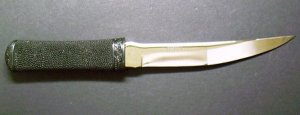



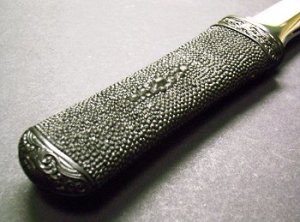
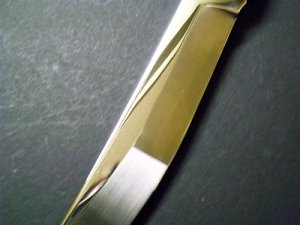
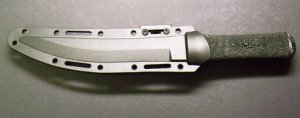
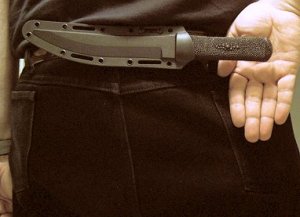
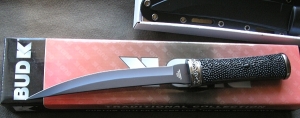
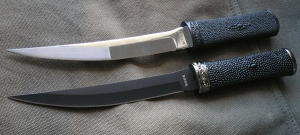
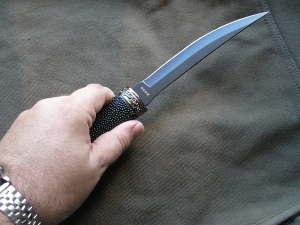
Thank you for insight. I was having a devil of a time with the Chicago screws but will be opting for the Tek-Lok. Well written and informative.